I’m well aware of the limit of 4.7 GB per game, however I did not know that drives formatted in FAT32 have only a 4 GB max file limit. Ps2 cannot read NTFS and now I am unable to transfer 90% of the games I want." - Reddit user, 5GumGum
Have you ever tried moving a large file to a storage device, only to get the dreaded "File is too large for the destination file system" error? This problem can be particularly frustrating when you're excited to use your files, like transferring games to a device.
This guide will help you understand the issue, discover 4 effective fixes, and ensure your files open smoothly next time.
In this article
Part 1: Understanding the “"File is Too Large for the Destination File System" Error

The "File is too large for the destination file system" error usually appears due to the way your storage device is formatted. Every storage device uses a specific file system, which sets rules for how data is stored and managed. Some file systems, like FAT32, have strict size limits for individual files.
Why does the “file is too large for the destination file system" error occur?
1. File System Limitation
FAT32 is one of the most common file systems, especially on older devices. However, it has a significant limitation: it cannot store files larger than 4GB. Even if your device has hundreds of gigabytes of free space, a single file larger than 4GB won’t fit.
2. Outdated or Incompatible Formats
Some older storage devices or memory cards may still use outdated file systems like FAT32. These file systems were designed years ago when large files were less common.
3. File System Errors
A corrupted or damaged file system can also cause this issue. For example, if a storage device has bad sectors or has been improperly ejected, its file system may not work correctly.
Part 2: 4 Effective Solutions to Fix the "File is Too Large for the Destination File System" Error
Now, you know why the error occurs. So, let’s look at how to fix the “File is too large for the destination file system" error. Each solution targets a specific cause of the problem.
1. Convert the File System of the Destination Device
File systems like NTFS and exFAT are designed to handle large files, unlike FAT32. Converting your device’s file system from FAT32 to one of these options removes the 4GB size limit.
What makes NTFS or exFAT better? NTFS is ideal for Windows users and supports advanced features like file compression and encryption. ExFAT, on the other hand, is great for devices that need to work with both Windows and macOS. The conversion process doesn’t usually affect the storage device’s performance, so you can still use it as usual after the change.
Step 1. Connect your storage device (USB, external hard drive) to your computer.
Step 2. Run the Command Prompt as an administrator.

Step 3. Type the command:
convert [drive letter]: /fs:ntfs
Replace [drive letter] with your storage device's letter (e.g., D:).
Step 4. Press Enter and wait for the conversion to complete.
2. Split the File into Smaller Parts
Is the file too big for FAT32? Splitting it into smaller pieces can solve the problem without changing the file system. Tools like WinRAR or 7-Zip allow you to divide large files into smaller, manageable parts.
For example, if you have a 5GB video, you can split it into two 2.5GB parts. Each piece can then be transferred to a FAT32 device without issues. This is also useful if you’re sharing files online, as smaller files are easier to upload and download.
Step 1. Right-click the large file you want to split and select Add to archive.

Step 2. In the WinRAR window, go to the Split to volumes, size. Enter a size limit for each part (e.g., 15MB). Then, click OK to create smaller parts of the file.

3. Compress the File
Compression reduces the size of your file by removing unnecessary data. If your file is slightly larger than the limit, compressing it might make it small enough to fit on the device.
Compression tools like 7-Zip and WinRAR let you shrink files without losing quality. This method is especially useful for text-heavy files, images, and certain videos. Compressed files can also save storage space, making it a great option for archiving or transferring multiple files.
Step 1. Right-click the large file.
Step 2. Go to Show more options.

Step 3. Choose 7-Zip. Then, select add to “your Image name.zip” or add to “your Image name.7z”.

4. Format the Destination Device
Sometimes the best way to fix the error is to format your storage device. Formatting erases all data and lets you choose a new file system, such as NTFS or exFAT. These file systems support larger files and are compatible with most modern devices.
Formatting is also helpful if your device has errors or bad sectors. A fresh format restores its functionality and prepares it for new data. Remember to back up your files before formatting to avoid losing important data.
Step 1. Connect your storage device to your computer.
Step 2. Open This PC in your folder and right-click your drive. Select Format.

Step 3. In the File system dropdown, choose NTFS or exFAT. Check Quick Format check box. It is for faster formatting. Then, click Start.

Part 3: How to Fix Damaged Large Size Files in One-Click?
Sometimes, large files may become damaged or corrupted during transfers or downloads. It can also happen when you compress or split large files. When this happens, you need a reliable tool to repair them. One great option is Repairit File Repair, a tool designed to restore corrupted files, like any large sized files.
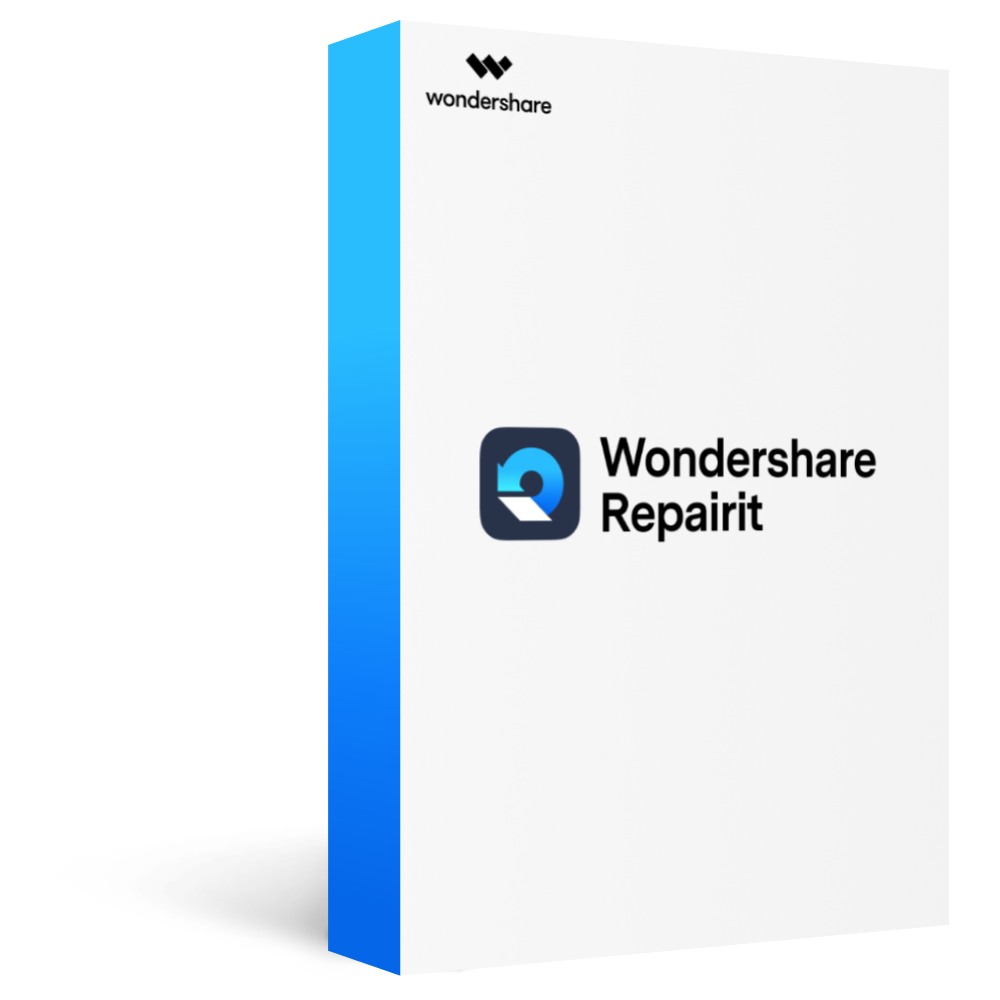
-
Repair damaged files with all levels of corruption, including blank files, files not opening, unrecognizable format, unreadable content, files layout changed, etc.
-
Support to repair all formats of PDF, Word, Excel, PowerPoint, Zip, and Adobe files.
-
Perfectly repair corrupted files with a very high success rate, without modifying the original file.
-
No limit to the number and size of the repairable files.
-
Support Windows 11/10/8/7/Vista, Windows Server 2003/2008/2012/2016/2019/2022, and macOS 10.12~macOS 14.
Repairit File Repair is an easy-to-use software that fixes damaged files of various sizes. It works quickly, so you can recover important files in just a few steps.
Why Use Repairit File Repair?
- Wide File Type Support. It can repair any type of large file. Repairit also fixes Word documents, Excel sheets, PowerPoint presentations, and PDFs.
- Advanced Repair Mode. Repairit fixes severely corrupted files by analyzing them deeply.
- Preview Before Saving. It allows you to see the repaired file before downloading it.
- Batch Repair. This tool fixes multiple files at the same time, saving you time and effort.
- Cross-Platform Compatibility. It is available for both Windows and Mac users.
- User-Friendly Interface. Even beginners can use Repairit without trouble.
Here is how to fix damaged large files using Repairit File Repair:
1. Open Repairit and navigate to More Types Repair. Pick File Repair.
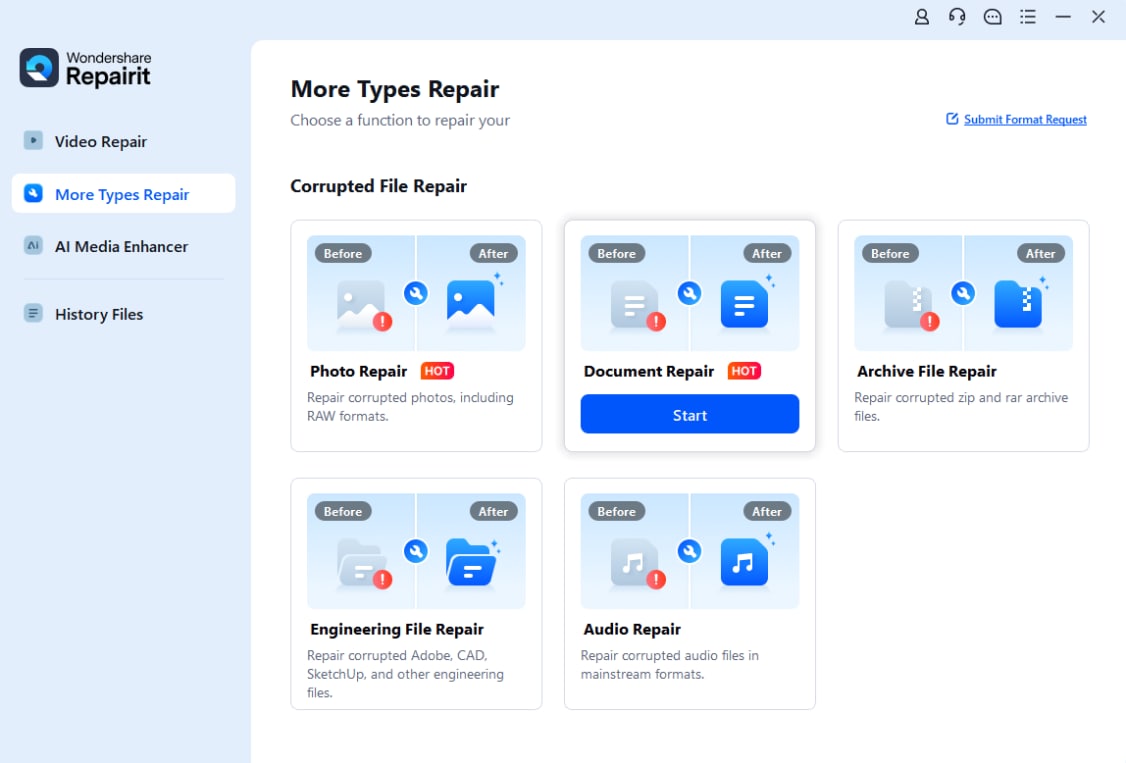
2. Click the +Add and upload the damaged large file.
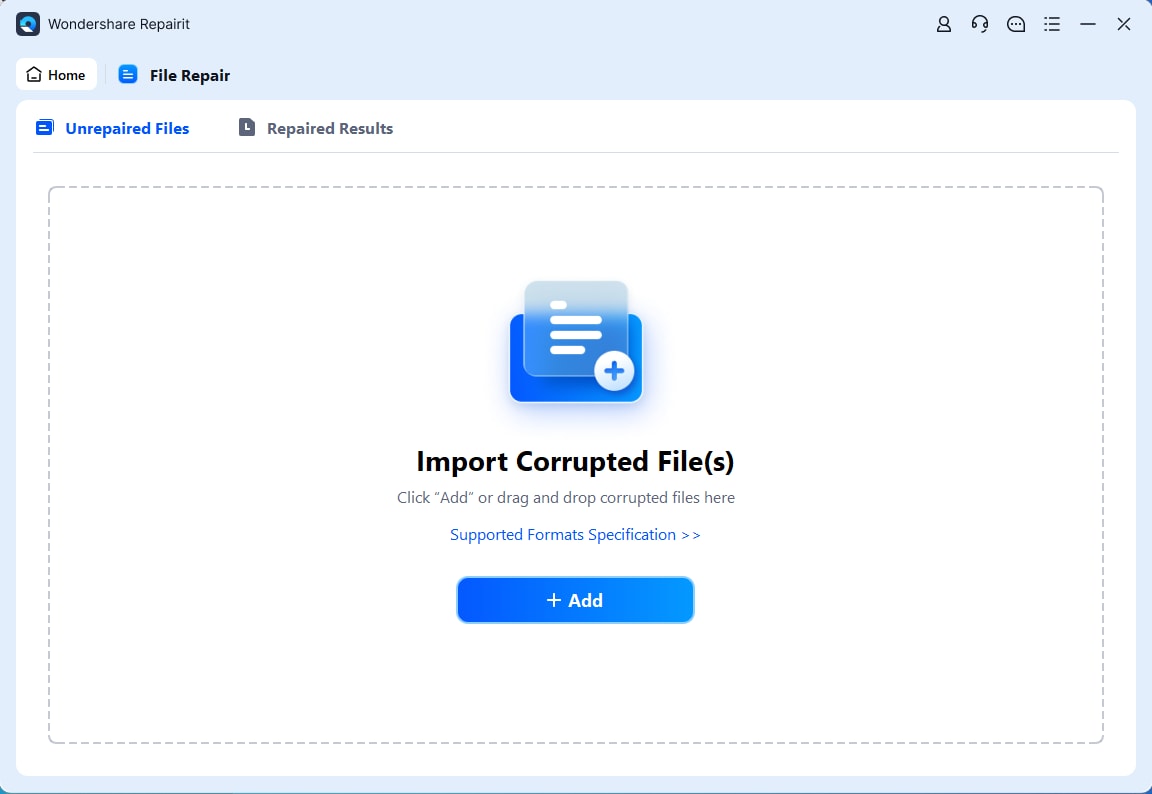
3. Hit the Repair button. After the process, you can preview the fixed file to check it.
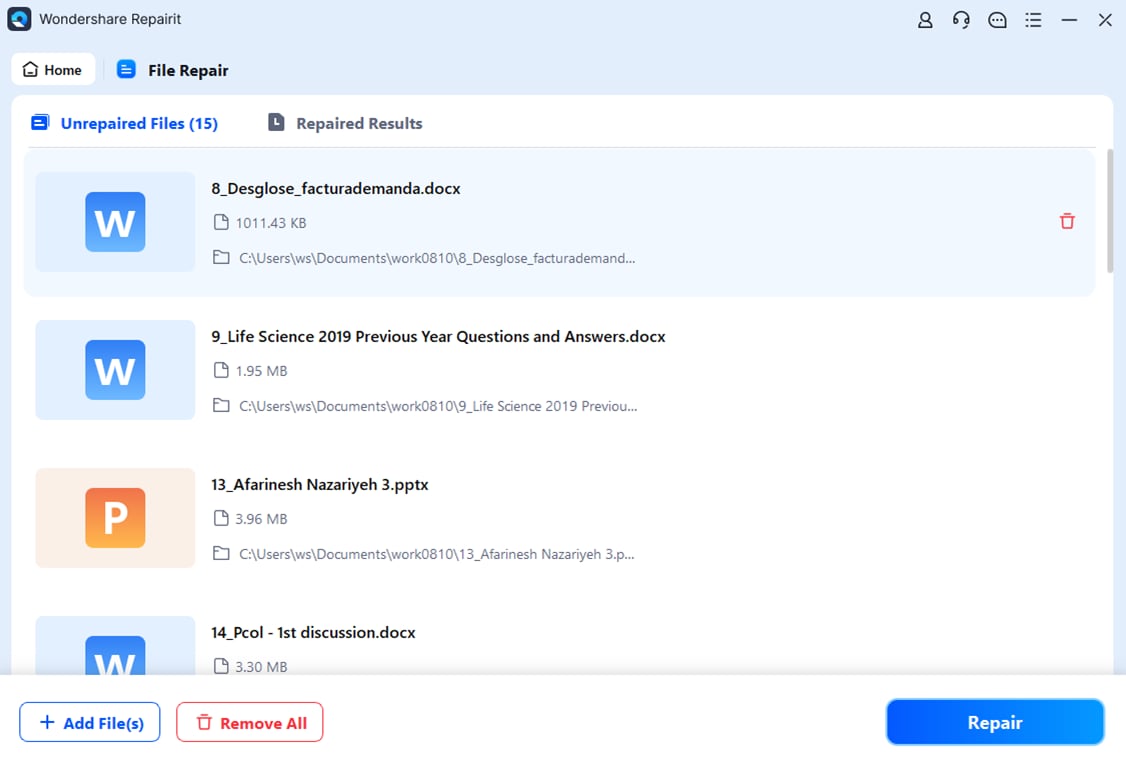
4. Click Save to store the repaired file in a safe folder.
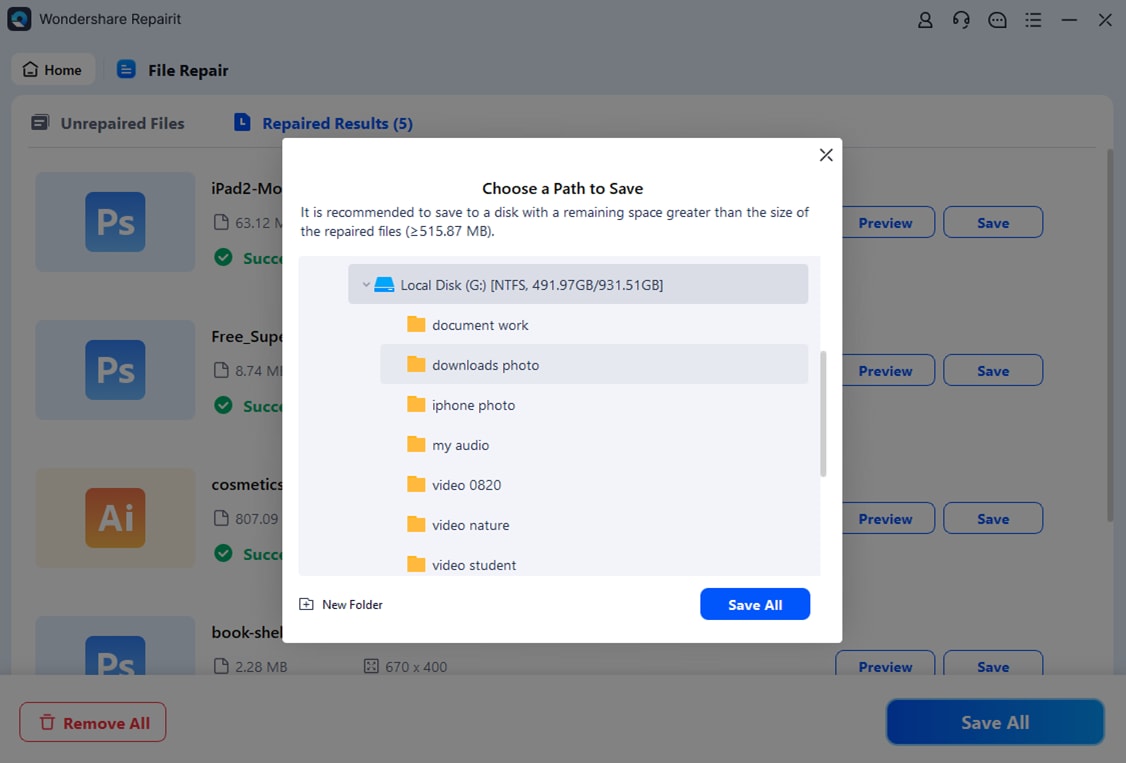
Fix Damaged Large Size Files in One-Click

Part 4: How to Prevent "File is Too Large for the Destination File System" Problem
Why face the same error again when you can avoid it? Preventing the "File is too large for the destination file system" error is easy if you make a few changes to how you store and transfer files. Here are ways to prevent it:
1. Use the Right File System: When setting up a new storage device, always choose NTFS or exFAT instead of FAT32. These file systems support large files and work with most modern devices. NTFS is great for Windows, while exFAT is better for cross-platform compatibility.
2. Keep Your Devices Updated: Use updated devices and software to avoid compatibility issues. Older drives and firmware might still rely on FAT32 or other outdated formats.
3. Organize Files Efficiently: If you often work with large files, consider splitting or compressing them before transferring. This ensures they fit on devices with stricter file system limits.
4. Check Storage Devices Regularly: Use built-in tools like Windows' Error Checking or Mac’s Disk Utility to find and fix problems with your storage devices. Regular maintenance can prevent file system errors.
5. Backup Files Frequently: Save copies of your important files in multiple locations. This way, even if a transfer fails, your files are secure.
Conclusion
The "File is too large for the destination file system" error is common but fixable. Understanding the causes and applying the right solutions, like compressing files, can help you overcome it. If your files are damaged, tools like Repairit File Repair make it easy to restore them. By following these tips, you can handle large files without any trouble in the future.
FAQ
What is the best file system for large files?
NTFS and exFAT are the best choices for large files. NTFS can handle file sizes up to 16 exabytes, making it ideal for Windows users who often work with massive files. It also supports advanced features like file permissions, encryption, and compression. exFAT is a simpler option that works well for devices needing cross-platform compatibility, such as transferring files between Windows, macOS, and some gaming consoles.Will converting my file system delete my data?
Converting from FAT32 to NTFS using built-in tools like the Command Prompt usually keeps your data intact. However, if there are issues with the drive, such as corruption or bad sectors, data loss can happen. This is why it's always a good idea to back up important files before starting the conversion.What’s the difference between compressing and splitting files?
Compressing files reduces their overall size by removing unnecessary data, making it easier to transfer or store them. Splitting files divides one large file into smaller, manageable pieces. This is particularly useful for file systems like FAT32, which have strict size limits, or when sending large files through email or online platforms.


 ChatGPT
ChatGPT
 Perplexity
Perplexity
 Google AI Mode
Google AI Mode
 Grok
Grok

